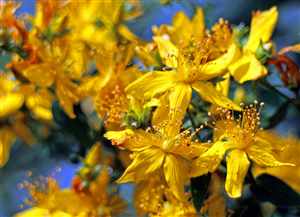St. John's wort (Hypericum perforatum)
Main Facts about St. John's wort

Using St. John's wort
St. John’s wort is most commonly used for depression (mild to moderate) and conditions that sometimes go along with depression such as anxiety, tiredness, loss of appetite and trouble sleeping. A 2005 study showed it was more effective than Prozac, without the side effects. Used alone, St. John's wort has improved mood in people with SAD, a type of depression that occurs during the winter months because of lack of sunlight. SAD is usually treated with light therapy, and there is some evidence that using St. John's wort together with phototherapy works even better. An early study suggests that St. John's wort may help relieve physical and emotional symptoms of PMS in some women, including cramps, irritability, food cravings, and breast tenderness. Two studies suggest that St. John's wort, combined with black cohosh, helps improve mood and anxiety during menopause. St. John's wort has antibacterial properties and may also help fight inflammation. Applied topically (to the skin), it may relieve symptoms associated with minor wounds and skin irritation.St. John's wort is a remedy for: Anxiety, Hemorrhoids
Caution!
Do not take St. John's Wort if you are taking antidepressants - leads to "serotonin syndrome", a condition marked by confusion and cardiovascular irregularities. Also don't use St John's Wort if you are tanning (could burn skin). St. John's wort may cause serious interactions with prescription drugs, herbs, or supplements.Cooking with St. John's wort
Flowers and leaves can be put into salads or made into tea. Tea can be used internally or externally for skin conditions, but remember not to go out in the sun after taking it. Is also available as liquid extract or dry herbs.How to grow St. John's wort
St. John's wort is planted early spring after danger of frost has passed. Best to first plant indoors in a warm, sunny environment and re-plant in late spring. Transplant when seedlings are around two inches tall. Propagated from cuttings, seeds, or division of roots. Seeds can take up to three months to germinate, and rootlets re-seed quickly. Flowers bloom in late July and August of the second year after initial planting. Harvest when flowers are in full bloom. Both the leaves and flowers can be harvested. Cut off the upper 1/3 portion of the plant in July for harvest.| Spearmint |
Black Tea
|